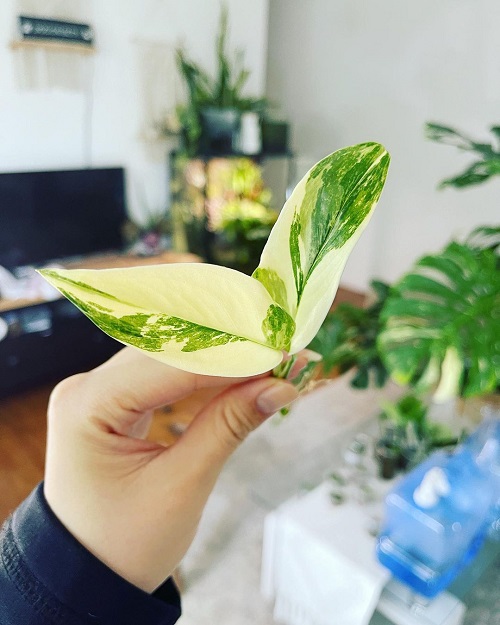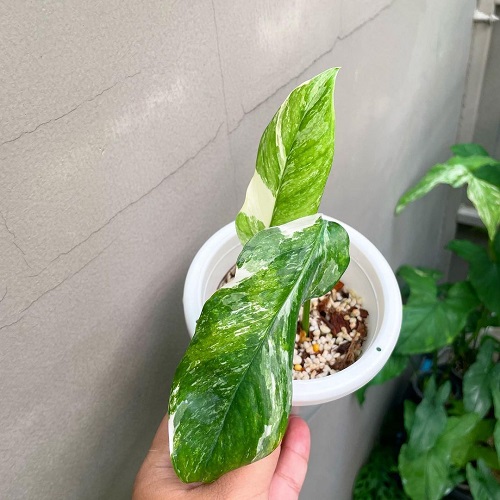Monstera Lechleriana is a beautiful gem that you must have in your indoor plant collection! Here’s how to keep it thriving!

Monstera Lechleriana—a captivating houseplant that’s an undiscovered gem in the vast Monstera family. With its uniquely patterned leaves resembling a mosaic of green art, this tropical beauty is a living statement piece that promises to elevate your indoor garden to new heights!
Check Best Monstera Varieties: The Ultimate Guide here
Monstera Lechleriana Information
Monstera Lechleriana is distinguished by its striking foliage—deep green leaves with intricate venation that creates a unique pattern reminiscent of a mosaic.
The leaves are generally heart-shaped or elongated and may reach lengths of up to 8-12 inches in a mature plant. Unlike its more famous cousin, Monstera deliciosa, the Lechleriana does not usually develop fenestrations (holes in the leaves) but instead maintains a lush, solid appearance.
Origin
This fascinating species is native to the tropical rainforests of Central and South America. The humid, shaded environment of its natural habitat plays a significant role in the plant’s care requirements and adaptability.
Leaf Features
Monstera Lechleriana leaves are typically glossy, and their deep green color can vary in intensity depending on lighting conditions. The leaves display prominent veins, which not only add texture but also contribute to its eye-catching appearance.
Juvenile leaves tend to be smaller and less intricate but grow to unveil their complex patterns as the plant matures.
Growth Habit
In its natural environment, Monstera Lechleriana is an epiphytic climber, meaning it grows on other trees but doesn’t take nutrients from them.
When cultivated as a houseplant, it exhibits a climbing or trailing growth habit, making it an excellent choice for hanging baskets or a trellis.
Unique Characteristics
While it may not produce the iconic split leaves seen in other Monstera varieties, the Lechleriana more than makes up for it with its textural depth and intricate leaf patterns.
It’s a less common species, which makes it a prized possession for collectors and enthusiasts looking for something out of the ordinary.
Check Monstera Acacoyaguensis Care and Growing Guide here
Propagating Monstera Lechleriana

Methods to propagate Monstera Lechleriana:
- Stem Cuttings
- Air Layering
- Division
Stem cuttings are one of the easiest and most common ways to propagate Monstera Lechleriana. Here’s how to do it in detail:
- Choose a healthy stem with at least a few leaves. Look for a stem that doesn’t have any signs of disease or damage.
- Use clean pruning shears or a sharp knife to cut a section of the stem that is around 4-6 inches long. Make sure there are at least one or two nodes (the small bumps on the stem where leaves and roots grow) on the cutting.
- Fill a small pot with a well-draining potting mix. Make a hole in the soil with your finger or a stick, and insert the cut end of the stem into the hole. Firmly press the soil around the cutting to ensure good contact.
- To create a humid environment for the cutting, you can cover the pot with a plastic bag or plastic wrap. This helps retain moisture and encourages root growth.
- Place the pot in a location with bright, indirect light. Avoid direct sunlight, as it can scorch the cutting.
- Keep the soil consistently moist but not waterlogged. Check the soil regularly and water when the top inch feels slightly dry.
- After a few weeks to a few months, you should start to see roots forming in the pot. You can gently tug on the cutting to check for resistance, indicating that roots have developed.
- Once the cutting has established a good root system, you can transplant it into a larger pot with well-draining soil. Treat it as you would a mature Monstera Lechleriana plant.
Learn Monstera Adansonii Propagation here
Best Pot Size for Growing Monstera Lechleriana

For Monstera Lechleriana, a pot size of 6-8 inches in diameter is suitable for young plants, while mature ones would love to grow in 12-14 inch pots. Go for terracotta or ceramic, as they promote moisture balance.
Ensure the container has drainage holes to prevent waterlogging, aiding root health and growth.
Requirements for Growing Monstera Lechleriana

Light
An ideal light for Monstera Lechleriana is bright, indirect sunlight. Place it near an east facing window for optimal sun exposure and bright colors in the variegated vareities. Avoid direct afternoon sunlight to prevent leaf scorch.
Soil
Here’s the best potting mix for Monstera Lechleriana:
- Coir or Peat Moss: 40%
- Perlite or Sand: 30%
- Orchid Bark or Organic Matter (Optional): 20%
- Worm Castings: 5%
- Activated Charcoal: 5%
- Coir or Peat Moss: Provides excellent water retention and is a good base for the potting mix.
- Perlite: Enhances drainage and aeration.
- Orchid Bark: Supports drainage and adds texture to the mix.
- Worm Castings: Supplies essential nutrients to the plant.
- Activated Charcoal: Helps in filtering the water and prevents odors.
Water
Water when the top inch of soil feels dry, typically every 1-2 weeks. Ensure proper drainage to prevent overwatering, which can lead to root rot.
Use room-temperature water to avoid shocking the plant. Adjust the frequency based on humidity levels and season, watering less in winter.
Temperature and Humidity
Monstera Lechleriana thrives in an indoor temperature range of 70°F to 90°F (21°C to 32°C). It prefers warm conditions and should be protected from temperatures below 50°F (10°C).
Maintain moderate to high humidity levels, around 50% or higher, to mimic its native tropical habitat and promote healthy growth.
Learn How to Grow Monstera Pinnatipartita here
Monstera Lechleriana Care

Fertilizer
A balanced formula like a 20-20-20 or 10-10-10 works best for Monstera Lechleriana. Dilute it to 1/4 of its strength and apply every 2-4 weeks will be more than enough to keep the plant happy and thriving.
Pruning
Occasional pruning is beneficial for Monstera Lechleriana. Use clean, sharp scissors or pruning shears to remove dead or yellowing leaves. To encourage bushier growth, trim back leggy stems just above a leaf node.
Pests and Diseases
Pests:
- Spider Mites: These tiny arachnids can infest Monstera Lechleriana, causing stippling on leaves and fine webbing. Regularly misting your plant and keeping humidity high can deter spider mites.
- Mealybugs: Mealybugs are small, white, waxy insects that cluster on the plant. They feed on sap, weakening the plant. Remove them manually or use insecticidal soap.
- Scale Insects: Scales appear as small, hard bumps on stems and leaves. They also feed on plant sap. Remove them with a soft brush or cotton swab dipped in rubbing alcohol.
- Fungus Gnats: These small flying insects are attracted to overwatered soil. Allow the soil to dry out between waterings to deter them.
Diseases:
- Root Rot: Overwatering or poorly draining soil can lead to root rot, causing root decay and a weakened plant. To prevent it, ensure the pot has drainage holes, and don’t let the plant sit in standing water.
- Leaf Spot: Fungal leaf spots can occur if the plant’s foliage stays wet for extended periods. Water the soil, not the leaves, and ensure good air circulation.
- Powdery Mildew: This fungal disease can affect Monstera Lechleriana leaves. Improve ventilation and avoid overcrowding your plants to reduce the risk.
- Bacterial Leaf Spot: Overhead watering and poor air circulation can promote bacterial leaf spot. Trim affected leaves and water the soil directly to prevent splashing.
Learn How to Get a Monstera to Bloom here
Monstera Lechleriana – FAQs
1. How Monstera Lechleriana is Different from Monstera Deliciosa?
While Monstera Deliciosa features large, heavily perforated leaves, Monstera Lechleriana has smaller, elongated leaves with less prominent perforations. The growth habit is also more climbing or vining in nature.
2. Is Monstera Lechleriana Pet-Friendly?
No, Monstera Lechleriana is toxic to pets. If ingested, it can cause irritation and digestive issues. Keep this plant out of reach of pets.
3. Does Monstera Lechleriana Flower?
Monstera Lechleriana rarely flowers indoors. When it does, the flowers are typically white and similar to those of other Monstera species.
4. Is Monstera Lechleriana Suitable for Terrariums?
Due to its preference for high humidity and moderate size, Monstera Lechleriana can be a good candidate for large terrariums or vivariums.

